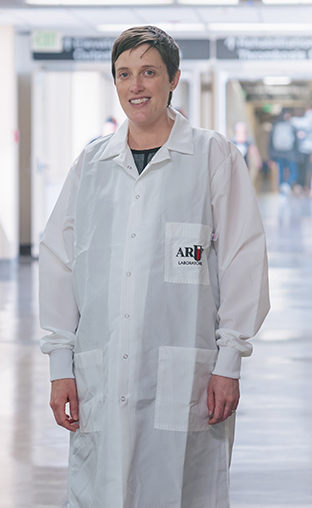What the C-Suite Doesn’t Know:The Effects of the Lab on Downstream Costs
Lauren Pearson, DO, MPH, has one foot in the world of laboratorians and one foot in the world of clinicians. She provides technical oversight and quality management for the ARUP labs located within University of Utah Health’s hospital and clinics. She also assists clinicians with medical decisions regarding test selection and result interpretation and has a role in systems quality and process improvement.

Poor quality can sink a ship. Beware of the iceberg effect, in which only a small portion of the costs of poor quality is visible, while much larger costs remain invisible below the surface. Many of the difficult-to-quantify costs of poor quality in a lab intersect with other healthcare system processes. They represent opportunities for improvement in system processes that will enhance overall patient care, safety, and the patient experience.
To tap into these opportunities, laboratory leadership needs to be included in multidisciplinary teams along with other stakeholders to continuously evaluate system quality and drive process improvement efforts.
How can the hospital and its lab leverage their strengths to improve patient care and decrease healthcare costs?
I think there are many opportunities for collaboration between labs and clinicians that can really provide improvements to patient care and enhance patient safety. When people and their areas exist as a silo, there are lost opportunities.
If hospital leadership really wants to amplify the work hospitals are doing to improve care, then they need to push for collaboration and give labs a seat at the table. When they do so, leaders will be surprised by how fast this drives change. All too often, the barrier for the lab is that people just don’t think about including them. Let’s face it, the lab itself is often out of sight and its laboratorians are not visible in typical patient scenarios, yet they are an integral piece of the puzzle in facilitating diagnoses and treatment.
These are lessons learned that our clients could benefit from. Granted, some clients are more resource limited than others, but that is even more of an impetus to effectively use their existing resources. Yes, some of the cost savings will come from utilization efforts, but the savings can be difficult to quantify: errora prevention, risk mitigation, and process and workflow improvements. Healthcare organizations know the cost affiliated with failure is a high one.
What do you think chief financial officers and CEOs may be unaware of when it comes to their hospital laboratories?

The lab is a rich source of data for a hospital. This data provides an opportunity to see what is or isn’t working well in regard to quality systems, existing processes, or workflow, because a lot of the clinical processes in caring for patients interface with the lab in some way.
Labs collect massive amounts of data for things that go well and things that don’t go well—it is a deep repository that can show where the gaps are and where the threats to patient safety exist. The lab has information on where processes need to be improved to make things better, faster, and safer for the patients.
ARUP runs several hospital and clinic labs. How does this make us different from other large national reference laboratories?
Being closer to where patient care is happening is always an advantage. And being closer to the provider makes us acutely aware of ever-evolving needs in the medical community, whether it’s a need for new assays, improvements on current assays, or process improvements to better meet the needs of patients and providers.
Our close relationship with University of Utah Health is unique. It is beneficial from both an operations and a quality perspective. Our culture at ARUP is connected to a higher purpose, which is to provide quality patient care at all times. We think of specimens as patients. Because of our connection to the university, we are receiving continuous feedback on how our level of service aligns with the healthcare system and patients’ needs. This also means we have to be flexible and agile and make changes when appropriate for patient care by offering new testing, extended hours of service, or reducing turnaround time.
The downside of making adjustments as needed to resolve issues or improve care is that it requires readily available resources. While another reference laboratory might say, “This is what we offer, take it or leave it,” we look to make improvements. This differentiates us.
Putting patients at the center of what we do makes us continuously strive to improve the laboratory side of care. I think ARUP’s connection with U of U Health and the university’s medical school creates an interesting dynamic that funnels a strong sense of purpose back into the company’s culture. It is not just about churning out lab results.

















 HOME
HOME